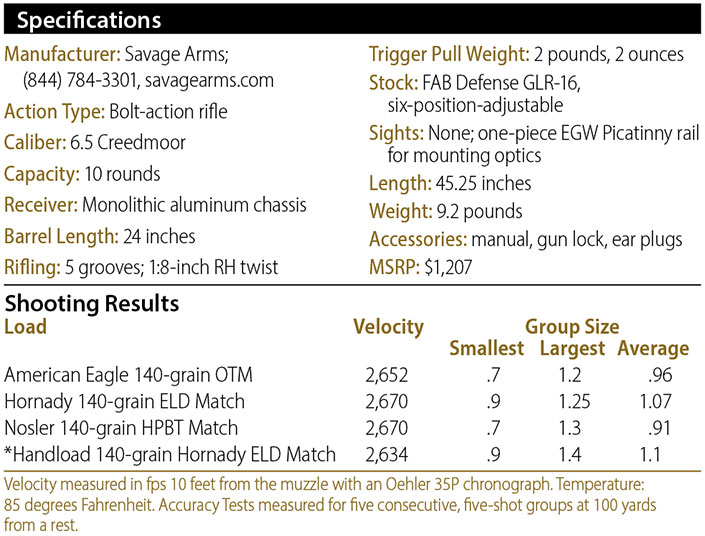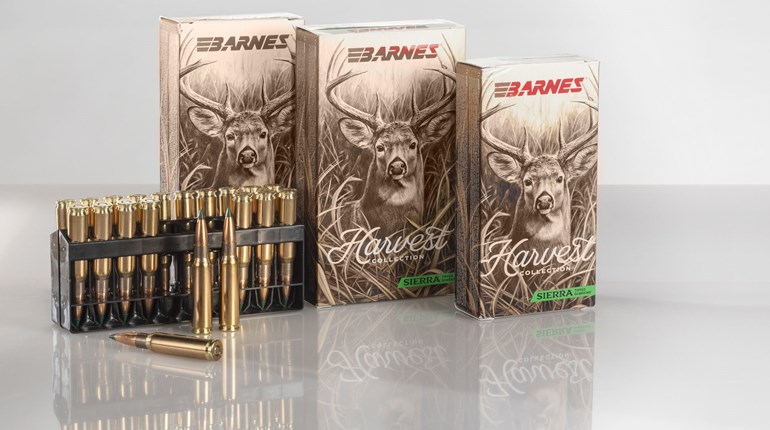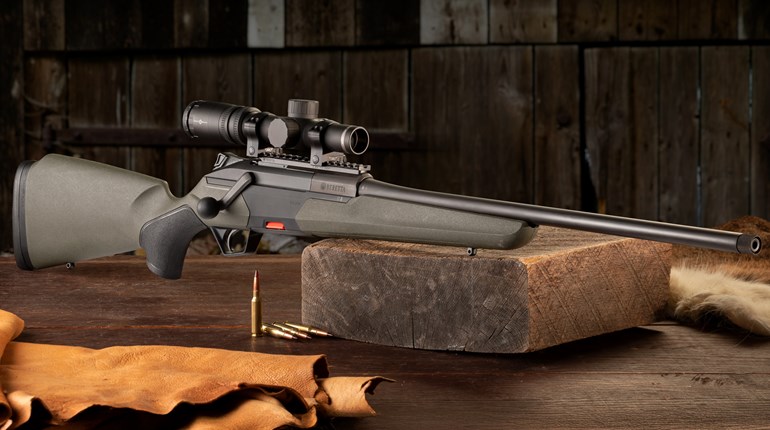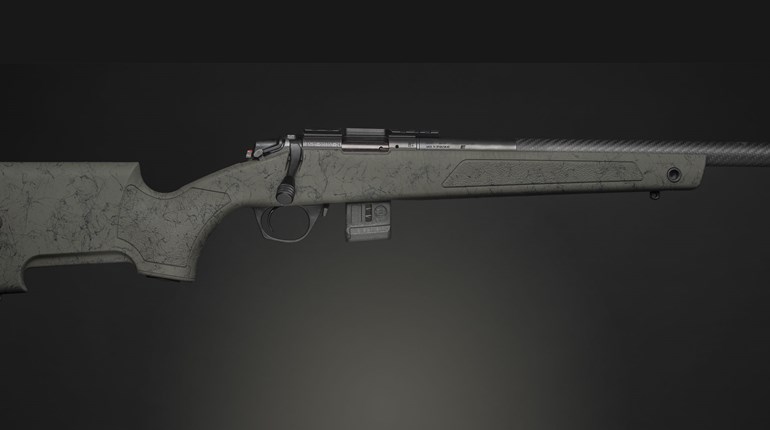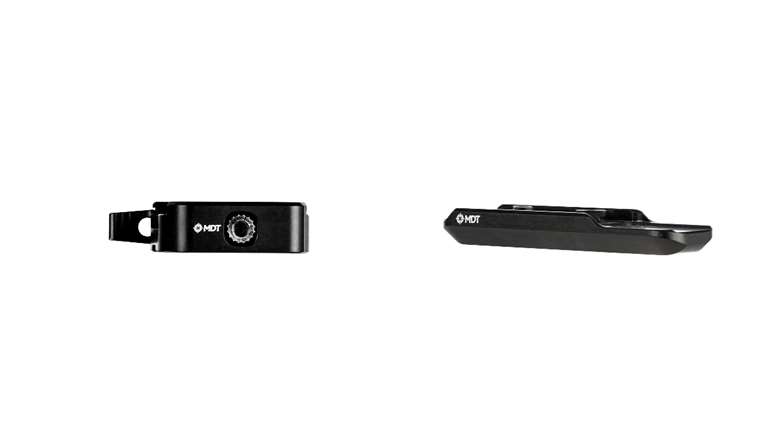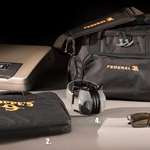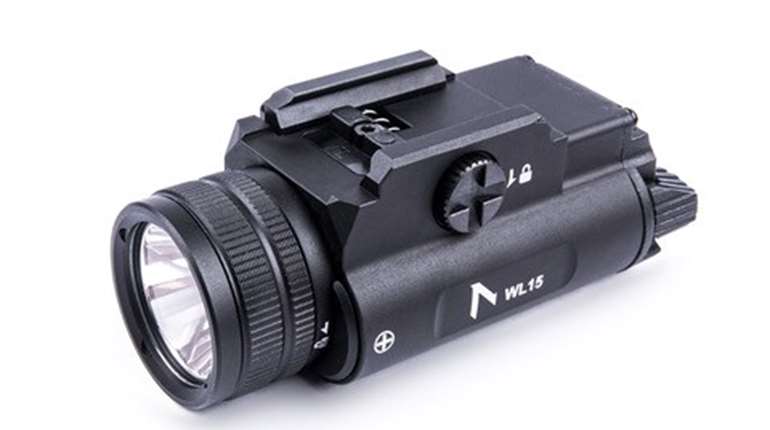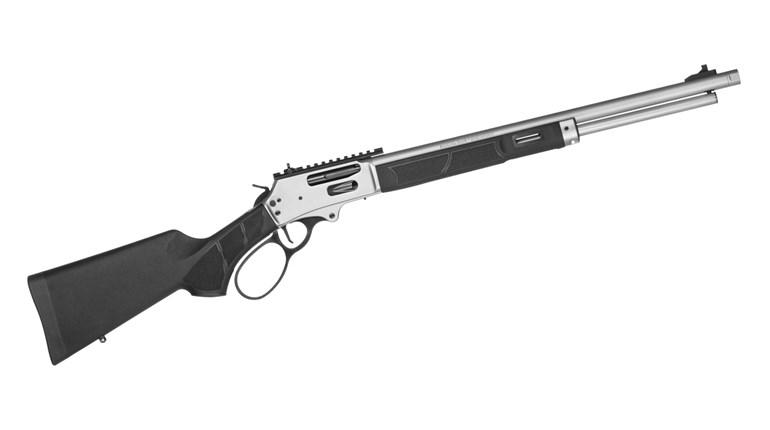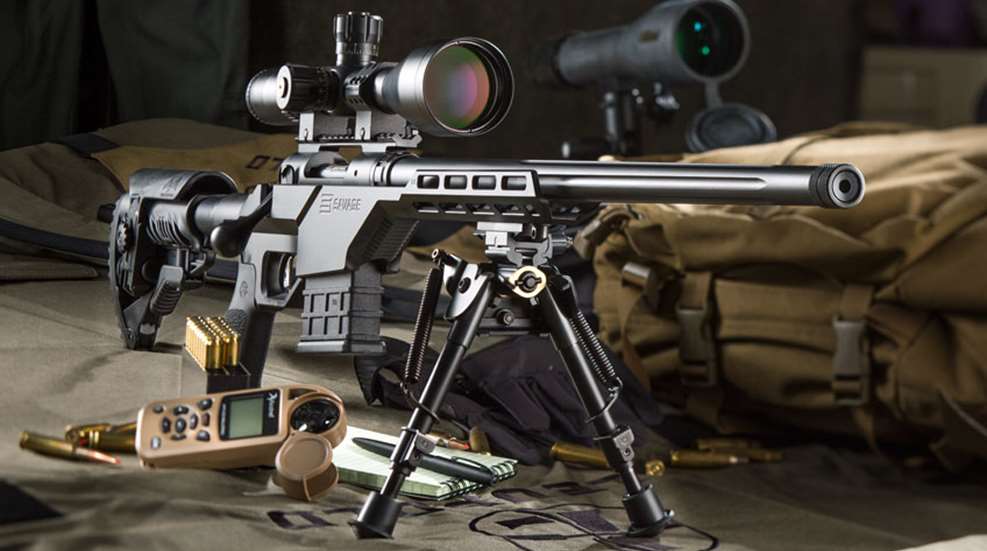
“It seems the whole wide world of shooting has gone mad over the 6.5 Creedmoor.”
This was the response from my friend Chris Hodgdon when I asked about the current state of Hodgdon H4350 powder and why it is so hard to find.
Hodgdon is right. The shooting world is going a bit nuts over long-range rifle shooting and the 6.5 Creedmoor is the shining star of that game. H4350 is the powder of record for this cartridge and is the most popular propellant with the 140-grain bullets most often used for long-range shooting.
This long-range thing is getting big, and gunmakers have taken notice. As a result, the world of precision rifles is changing. Not so long ago the price for an entry-level, chassis-built precision rifle was about $2,500 and it went up from there with no limit. Then Ruger screwed it all up with its Precision Rifle. That rifle was selling for less than a grand on the street and was more than accurate enough to run with the big dogs at the range.
Savage was quick to respond to the changing market. The company already had chassis rifles, the Model 10 BA and 110 BA. They represented an outstanding performance-to-dollars spent ratio as the rifles proved to be quite accurate and dependable. But, the guns were a bit expensive and heavy. Heavy is what the market wanted at one time, but the market is a fickle vixen and to survive you need to keep up. Heavy is fine for shooting at a fixed position, but with the emerging popularity of Precision Rifle matches, weight became a factor. Now that shooters are moving more with the rifles, they want less weight.
The 110 BA is a hell of a rifle; I know, I have one in .338 Lapua Mag. and it’s accurate enough to run in front of most of the big dogs. I have tested a lot of .338 Lapua rifles over the years, all of them more expensive than the Savage, but only one has been more accurate. That was a $10,000 AI rifle. The thing is, the 110 BA is a beast, it’s big and it’s heavy. That’s not necessarily a bad thing, as it tames the Lapua’s recoil. But, if you want a competition rifle to carry and shoot, that “ain’t it.” Even chambered for smaller cartridges in the short-action Model 10 BA, the rifle is a bit heavy by today’s standards.
“We decided to build a rifle that delivered the same accuracy that the 10 and 110 BA were famous for, but at a manageable weight, with a modern chassis and attractive price,” said J.J. Reich, communications manager for Savage Arms.

The new rifle is called the Savage BA Stealth. In the short action it has the 10 designation and in the long action it has the 110 designation. I first saw that gun at the 2016 SHOT Show where the company had a Model 10 BA Stealth in 6.5 Creedmoor set up for long-range shooting at Media Day. It was already dialed in and I was hitting a steel target at 850 yards right from the first shot. In fact, it was too easy and got a little boring, so I moved on after a few shots. But, the rifle was very interesting and I asked Reich to make sure I got one to try when they were in production.
Fast-forward to early summer and I now have one of the new Stealth rifles in my hands. It’s in 6.5 Creedmoor, of course. The gun will be offered as the Model 10 Stealth short-action in 6.5 Creedmoor and .308 Win. The .308 Win. is clearly aimed at the Law Enforcement market with a short 20-inch barrel, but the 6.5 Creedmoor has a 24-inch barrel and is out-of-the-box-ready for long-range shooting. Savage also will offer a long action Model 110 Stealth option in .300 Win. Mag. and .338 Lapua Mag. For those shooters who want to go past 1,000 yards, these cartridges carry the freight better. I have shot out to 1,800 yards with the Lapua and nothing matches it for ultra-long range performance.
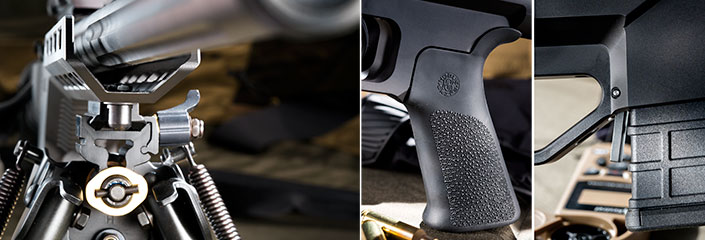
That said, in my never-humble opinion, the 6.5 Creedmoor is going to dominate sales, at least until the 6 mm Creedmoor hits dealers’ shelves. Its mild recoil and outstanding accuracy out to 1,000 yards and beyond makes it the obvious choice. Besides, as Chris Hodgdon noted, it’s the hottest long-range rifle cartridge on the market right now. So, I asked for my test gun to be in established 6.5 Creedmoor.
The first thing I noticed when I opened the box is that this is a lighter and more-streamlined rifle than most of the chassis-built precision rifles I have handled. At 9-plus pounds, it’s not a lightweight, but it’s still a pound or more lighter than most other, similar rifles. That’s kind of a mixed blessing. The lighter gun will be welcome in a match or any situation where the rifle will be carried and the shooter is required to walk, hike, run, climb or move in any way. On the other hand, the recoil is a little bit stouter than I am used to from a 6.5 Creedmoor precision rifle. It’s still not much compared to the bigger cartridges; after all, it’s still a 10-pound-plus gun with an optic mounted, but that little extra jolt every time the gun fires can have a cumulative effect over the course of a long day of shooting.
The answer, of course, is to install a muzzle brake. The muzzle is threaded 5⁄8x24 tpi to allow easy installation of a muzzle brake or a suppressor, and comes with a thread protector cap. It’s a twist-on install for an aftermarket brake. Most serious shooters are going to use a brake anyway. In the end, the light weight wins the plus category, as the one resulting downside—felt recoil—is easily mitigated.

The Drake Associates Hunter/Stalker chassis is slim and trim by most standards. This is a monolithic chassis machined from a single piece of aluminum rather than a bolt-together multi-piece chassis. It has M-LOK slots on the fore-end. There is a front swivel stud to mount a bipod. It features a slim, relatively short fore-end. This rests well in sandbags or on a machine rest as well as on a bipod, so it gets the job done without adding extra bulk or weight. It also leaves a lot of the fluted barrel exposed to the air for faster cooling.
The FAB Defense buttstock is adjustable for length and has an adjustable cheek rest. It has a rubber buttpad and holes on both sides for quick detach-sling swivels. If it’s not your style, it can be replaced with any aftermarket AR-15-style commercial-spec buttstock. The grip is also AR-15 style and is a Hogue model in black rubber.
There is a Drake Picatinny rail screwed to the action to mount an optic. This is one other small complaint. The No. 6 screws are Allen head and tend to work loose. Who uses Allen-head screws to mount big riflescopes these days anyway? A Torx-head screw can be tightened with a lower risk of stripping. I pulled all the screws and added Loctite to the threads with the hope that they will stay secure. I would have preferred the larger No. 8 screws, as precision rifles usually are coupled with big, heavy optics, but the No. 6 is the industry standard, so I can’t fault Savage for sticking with them.
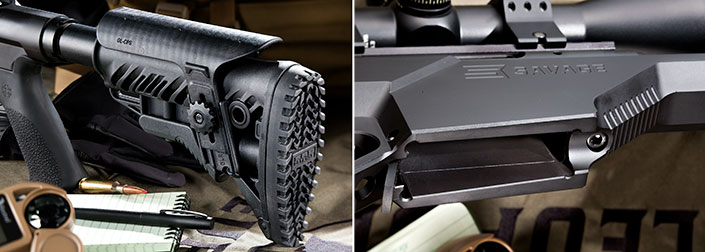
The magazine release is a large lever in front of the trigger guard that is pushed forward to release the magazine. The polymer magazine holds 10 rounds and feeds from the center. The magazine is one of the few complaints I have with this rifle. When it’s full of cartridges, the sides bulge, which makes it a bit hard to insert into the rifle. Also, it will not take ammo with the bullet seated past about 2.810 inches. My handloads are 2.823 inches and would not function in the magazine. The SAAMI maximum cartridge overall length is 2.825, so the handloads are within spec. This cartridge was designed around long, heavy bullets and part of the concept of accuracy is to be able to seat the bullet to the depth that maximizes the accuracy. That means the ability to seat out past SAAMI specifications can be important. But in this magazine that will be impossible. The upside is any AICS aftermarket magazine will fit the gun.
The heavy 24-inch barrel measures .750-inch just behind the muzzle threads. It’s finished with a tapered 11-degree target-style crown. The Savage barrel is button rifled and is fitted to a blueprinted receiver. This means the receiver, bolt and other parts are all trued and mated as a package. This is one of the things that you buy when you pay a gunsmith to custom-fit an action and it can cost several hundred dollars, but is part of the package with this Savage rifle. The Savage-style barrel nut allows for very precise control of the headspacing. It also allows for easy replacement of the barrel if you ever manage to shoot it out or want to upgrade to a high end aftermarket barrel.
The bolt has an integral oversize knob, which makes it easy to grab when wearing gloves, and it runs smooth in the action. The trigger is the adjustable Savage AccuTrigger, which broke at 2 pounds, 2 ounces pretty consistently, so I left it alone. I like this trigger weight in a precision rifle; light enough to shoot well, but not so light I lose control of the rifle.
I have tested this rifle over multiple range sessions, including the Shooting Illustrated protocol of five, five-shot groups at 100 yards, which I did with four different ammo products. This is a precision, long-range rifle intended for tactical and target use, so I stuck with the standard 140-grain bullets designed for that purpose. I tested four factory loads and one proven handload and they all shot about the same, about a tenth of an inch either side of 1 inch.
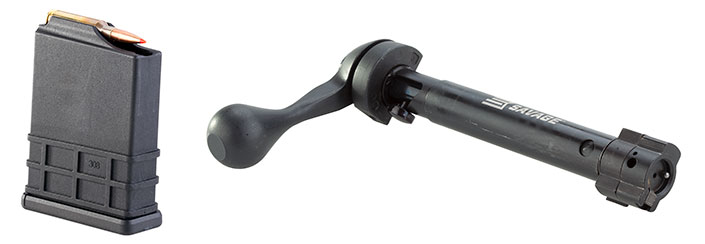
I shot the new American Eagle 140-grain OTM load out to 300 and 500 yards as well. The two 300-yard, five-shot groups were 1.8 and 3.5 inches. The average of the two is 2.65 inches, which is less than 1 MOA. At 500 yards the two groups were 5.0 and 4.5 inches, again with an average slightly less than 1 MOA. If nothing else, the accuracy of this rifle is boringly consistent.
I believe that right now, this is the lowest MSRP for a precision rifle on the market from a major manufacturer. The Savage Model 10 Stealth represents a great bargain for those wanting to enter the exciting world of long-range shooting without taking a second mortgage on the house. Low price here, though, definitely does not signal compromise. This is a rifle that is fully capable of winning matches.

